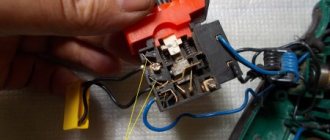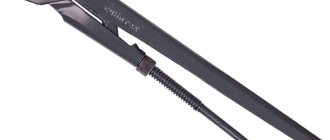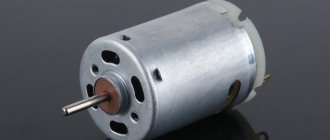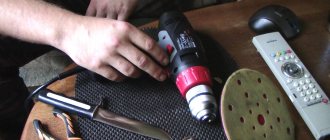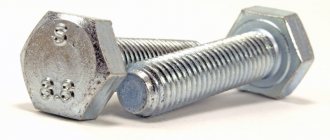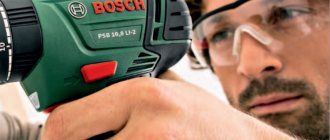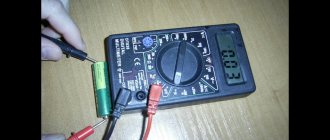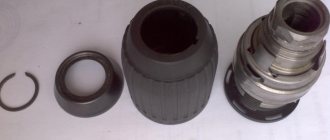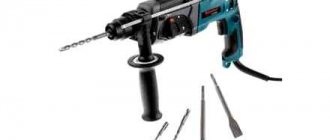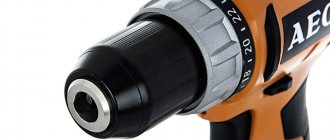Features and types of instruments
The screwdriver can be battery-powered or mains-powered. The type of operation of the tool can be different; in this regard, it is customary to distinguish the following types:
- drill-driver;
- impact wrench;
- cordless screwdriver;
- ordinary screwdriver.
According to the type of work, screwdrivers are divided into several types: screwdriver, drill-driver, impact wrench and cordless screwdriver.
The operating principles of each of these tools are similar, the difference between them lies in the functions for which they are intended.
A drill-driver additionally allows you to drill a hole, while a regular one is intended only for working with fasteners. The impact wrench is designed to work with bolts and nuts, and the cordless screwdriver is designed to tighten and unscrew fasteners with Phillips heads. The last device has the lowest power of all.
A screwdriver is indispensable if you need to make a suspended ceiling, install drywall or sheet insulation. The absence of this device greatly complicates the work, during which it is necessary to tighten many screws or other fasteners. And in everyday life, when you need to screw in or unscrew one screw, doing this with a screwdriver is much more convenient and faster.
Magnetization and hardening of attachments
A large number of nozzles are made in China from soft material. Therefore, they quickly lose their shape. A new bit doesn't last long. To extend its service life, the nozzle must be hardened. You will need: machine oil, a gas burner or gas stove, a small container for oil from any tin can, a piece of steel wire.
- Wrap the wire around the bat so that it does not fall out.
Bat wrapped in wire
The bat must be red hot
A hardened bat will last longer than a regular one.
Video: oil hardening bits
For ease of use, especially in hard-to-reach places, the nozzles are magnetized. This can be done in several ways.
Method 1
You will need to purchase a special device for magnetizing and demagnetizing screwdrivers. Insert the bat there. A square window magnetizes, while a stepped window does the opposite.
Device for magnetization and demagnetization
Device for magnetization and demagnetization
Method 2
Circuit diagram for magnetization
Method 3
Magnetizing a bit with a magnet
Video: magnetizing attachments with a magnet
Method 4
- Buy neodymium magnets at a radio store.
- Divide them into two parts and place them in one row so that the resulting groups repel each other. Place a plastic pen cap between them. To hold the repelling magnets, secure them with plasticine.
Magnetization with neodymium magnets
The process of magnetizing bits with neodymium magnets
As a result, the attachment will magnetize the fastener better than a new one.
Video: magnetizing bits with neodymium magnets
Device setup and design features
The design of the tool is quite simple. The plastic housing houses a motor and a gear mechanism that drives a bit located at the end of the device. The design also includes a power switch, direction and speed switch, LED backlight, and tightening torque regulator.
Before using a screwdriver, you need to select an attachment for it that will correspond to the size of the head of the self-tapping screw or screw.
The operating principle of the tool is as simple as its design. The nozzle, fixed in the cartridge, is driven by a shaft, which begins to move from the engine through the gearbox. Before starting to work with a screwdriver, you need to check whether the battery is charged and whether the required attachment is installed.
To install the required nozzle, you need to select it according to the size of the head of the fastener and insert it into the magnetic holder of the cartridge. To do this, the cartridge and coupling must be removed from the device. After installing the required bit, the cartridge is reattached to the tool body.
Next you need to set the optimal bit rotation speed. This can be done using a special regulator. The required mode is set on the device being used before it is used. You can also switch the direction of the bit's movement.
Before using a screwdriver, you need to adjust the depth of screwing of the fastener. Over time, it may be necessary to replace the magnetic holder in the socket. To replace the magnetic holder, the cartridge and coupling, the magnetic holder are removed, and another is installed in its place. After this, the chuck with the coupling is installed back into the screwdriver body.
How to use a cordless screwdriver correctly
Naturally, the main feature of a cordless screwdriver is its mobility in operation. It can be used in places where there is no electricity or access to it is limited. When performing various types of installation, assembling furniture and other work, a screwdriver will become an indispensable assistant. The presence of a second battery in the package allows you to continuously work with a screwdriver, using one and charging the second. When operating any tool, you must remember to comply with safety precautions, as well as its correct use, which will be discussed further.
To start working with a screwdriver, you need to fully charge the battery, no matter if it is a Makita or an inexpensive Chinese tool. It’s good if the screwdriver has an indication of the battery charge level, which will make using the battery convenient. To start charging, you need to connect the charger to the network; the green indicator light will light up. The battery has a special groove, thanks to which it can only be inserted into the charger in the correct way, which will protect the battery from reverse polarity. The battery must be installed tightly so that the contacts of the charger and battery fit securely against each other.
After installing the battery into the adapter, the red indicator will light up, indicating the charging process. When charging is complete, the indicator will change color to green. After fully charging, install the battery into the screwdriver. So, you can get to work. It is worth noting that the color of the indicators may differ from one manufacturer to another, but the process itself is always exactly the same. Torque adjustment
A distinctive feature of the screwdriver is the presence of an adjusting ring, which is responsible for torque. This feature allows you to avoid excessive screwing in or stripping the screw slot. Thanks to a special mechanism, the chuck stops when the screw is tightened, and the engine continues to run. You can use the adjustment ring to set the drilling mode. In other positions of the regulator, the clutch will begin to slip at a certain force. The engine speed switch (if equipped) allows you to use two speed modes with a lower or higher number of revolutions.
An absolutely necessary thing in a screwdriver. This switch is used to change the direction of rotation of the chuck. In the central position, the switch blocks pressing the start key. In the other two positions, the chuck will rotate clockwise and counterclockwise, allowing screws to be screwed in and out. This key is always located above the start button in such a way that you can change the direction of rotation of the cartridge with your thumb and forefinger without using your second hand.
Installing the bit into the chuck
Screwdrivers can have a keyless plastic or metal chuck, which greatly simplifies the process of installing and removing the bit, but many models have hex chucks, i.e. Allows you to directly insert a bit or tool without twisting. To secure a drill bit or bit into a keyless chuck, insert it into the screwdriver as far as it will go and tighten the chuck by hand. You can also hold the front of the cartridge and pull the trigger and the cartridge will unwind.
Safety precautions when using a screwdriver
Use the tool only after making all necessary settings. To get started, you need to connect the device to the network or connect a battery to it. After this, you can turn on the screwdriver and perform the actions for which it is intended, that is, tighten or unscrew the fasteners. Compliance with operating rules allows you to extend the service life of the tool and get better results in a shorter time.
Adjusting the movement of the bit is strictly prohibited while the screwdriver is operating. Care must be taken to ensure that no moisture gets on the instrument or inside its body. It is strongly recommended to use the device only in sufficient lighting conditions. In addition, if the tool is networked, then the electrical network must operate without voltage drops.
Contact between the screwdriver and grounded objects is strictly prohibited. If this happens, the technician may receive an electric shock. Do not allow the device to overheat due to prolonged continuous operation. If the screwdriver is not allowed to rest, it may burn out. The instructions for the tool must be studied in detail before using it. You should not work with a screwdriver if any faults are detected in it.
It is advisable to wear special protective clothing while working.
Thus, despite the simplicity of the design and operating principle of the device, not every novice craftsman knows how to use a screwdriver correctly in order to extend its service life. Compliance with some simple operating rules will ensure the safety of the master, the safety of the device and the excellent quality of the result.
The screwdriver has successfully replaced not only various types of screwdrivers, but also wrenches and hex keys. This tool is also used instead of a drill. For builders and furniture makers, an electric screwdriver has become an indispensable assistant. There are always uses for it at home. The range on the market is represented by a wide variety of models. Despite the prevalence of screwdrivers in various fields of activity, not all users, especially beginners, know how to operate them. Proper use, maintenance and storage of power tools will maximize their service life.
Read also: Do-it-yourself home tire fitting drawings
Safety precautions at work
It is very important to adhere to safety precautions when using a screwdriver, which will make it possible to avoid injury, electric shock or fire. Experts recommend to masters:
- Before you start drilling into the walls, make sure there are no hidden wiring.
- Avoid exposing the instrument to direct sunlight. In summer, it is best to place the instrument in the shade.
- During operation, avoid touching a grounded object, such as a pipeline, heating radiator or gas stove. Before touching these items, you must unplug the cord from the outlet.
- Hold the screwdriver by the insulated part of the body. Contact with a damaged cable may cause tension in the metal part of the tool. In this case, the person may receive an electric shock.
- Turn off the device when moving to another place or before removing the attachment from the screwdriver.
- Unplug the plug from the socket after working with the tool is completed to replace one of the structural elements, before removing the drill from the screwdriver.
- Use a special double insulated extension cord when working outdoors.
- Wear special clothing designed for working with a screwdriver. It is best to give preference to loose clothing. Jewelry should be removed from your hands so that it does not get caught in the moving part of the instrument.
- Do not touch or try to slow down the rotating part of the power tool.
Before work, it is important to visually inspect the screwdriver and power cord for damage. It is also worth making sure that unnecessary tools have been removed from the work area and that replacement parts have been installed correctly.
If additional noise comes from the tool during operation, you should unplug the cord from the outlet as soon as possible.
Beginning craftsmen often have difficulties when working with power tools. Even simply replacing drills seems like a daunting task. In order not to make mistakes during the work process, you should follow the step-by-step instructions that answer the question - how to change the bit in a screwdriver. Soon even this task will seem mundane.
Design and principle of operation of a screwdriver
According to the feeding method, screwdrivers are divided into two types:
- network, connected to networks with a voltage of 220 V;
- rechargeable batteries that use the energy of the accumulated charge.
Recently, instruments with a combined power supply have also appeared. They combine all the advantages of both varieties.
The external and internal design of network and battery models is almost the same. In general, a power tool consists of the following structural elements:
- housings;
- cartridge;
- power buttons;
- switch for the direction of rotation of the electric motor (reverse);
- speed controller (number of revolutions);
- power lock buttons;
- tightening force regulator (torque value switch).
The photo below shows the design of a cordless screwdriver.
A number of models are additionally equipped with lighting, which is structurally implemented in different ways. Not every product has a speed controller and a power lock button. Corded electric screwdrivers have a power cord, while cordless ones have a charge storage unit installed instead.
The body of a power tool is most often made of plastic, and much less often - of alloys of different metals. For convenience, it usually consists of 2 halves. Inside the case there are the following main parts:
- electric motor (DC or AC);
- pay;
- capacitor;
- gearbox;
- coupling
The electrical connections vary depending on the model.
An electric screwdriver can be equipped with different types of chucks. The most widely used is the quick-clamping three-jaw version of this part. The cartridge also consists of separate parts, which are shown in the photo below.
It should be taken into account that if the purpose of the screwdriver is highly specialized, then this may introduce some design changes.
The operating principle of both corded and cordless screwdrivers is the same. It consists in the fact that electrical energy drives an electric motor to rotate. Through the gearbox and shaft, force and speed are transmitted from the motor to the attachment fixed in the chuck. She is already drilling a hole or screwing or unscrewing fasteners. A peculiarity of the process is that the electric motor in network models operates at an alternating voltage of 220 V, and in battery-powered ones - at a constant voltage, the value of which can be in the range from 3.5 V to 36 V.
Types of bits for a screwdriver: how to choose
To choose the right nozzles, you need to study their varieties. First determine the shank shape type and diameter. It ranges from 1/4 to 1 inch.
- splined. They differ in the width and thickness of the slot;
Spline bits of different widths and thicknesses
The drywall bit has a stop stop
Spring Lock Bit
Combination bits have two types of shank shapes or one, but of different sizes. For example, a splined shank and sprocket.
Example of a combination nozzle
Splined shank and sprocket
Determine the length of bit you need for the job. It ranges from 10 to 200 mm.
Depending on the shape of the shank, the nozzles have a certain marking:
- Sl (Slot) – splined;
- Ph (Philips) – cross-shaped universal;
- Pz (Poz >An important characteristic is the grade of steel from which the bat is made. The nozzle may have a protective coating. The strength of the equipment depends on this. The main types of steel and coatings that should be given preference:
- Cr-v - chrome vanadium steel. The most common, with increased hardness;
- Cr-Mb - chromium-molybdenum steel. Less common. Very durable material;
- Ni - nickel coating. Increases resistance to corrosion;
- WC - tungsten carbide coating. Increases strength;
- Tin - titanium nitrite yellow coating. Increases strength.
Tin - coating for increased strength
Nozzles vary depending on the purpose:
Considering all the parameters considered, you can easily select the necessary bits.
Changing attachments
Changing the attachment on a screwdriver is not difficult. The tool can be equipped with a quick-release chuck or a key-type chuck. Replace the equipment in both cases in a similar way. To remove a drill from a screwdriver with a keyless chuck and insert a new one or another type of equipment, proceed as follows:
- first, select a bit according to the size of the head and the type of slot on it (cross, straight or other) or a drill of the required diameter corresponding to the material in which the hole is to be created;
- spin the cartridge counterclockwise;
- in the center, between the spread cams, install the selected type of equipment;
- Rotating the cartridge case in the direction of the clock hand, clamp the nozzle.
You can remove the drill bit from the screwdriver (or another attachment) by holding the moving part of the chuck with one hand and pressing the start button with the other. Just first switch the direction of rotation to unwinding.
When a drill-driver is equipped with a key chuck, then to change the equipment do this:
- inserting the key into the recess for it, unscrew the cartridge;
- I install the nozzle;
- clamp it by turning the key clockwise.
There are models in which you can remove one type of cartridge, for example, a quick-detachable one, and replace it with a turnkey analogue . When choosing any option, you need to focus not only on ease of use, but you should also consider the pros and cons of each of them. Thus, the key chuck securely clamps the equipment, which is important when drilling, and the quick-release chuck allows you to quickly replace it, even with one hand (the other holds the handle, pressing the start button as necessary).
Installing a drill into a screwdriver
How to insert a bit into a screwdriver is a question often asked by novice craftsmen. Depending on the type of chuck, the method of installing the cutting tool intended for drilling holes will depend. To avoid mistakes, it is worth learning how to insert a drill into a screwdriver.
- To install the drill, the master must unplug the screwdriver and select a suitable cutting tool designed for drilling holes.
- The drill is cleaned of dust and dirt. It is important to pay attention to the tail section. All plaque should be removed.
- In cases where a quick-release chuck is installed on the tool, it is necessary to manually open its jaws. If a gear type chuck is used, it is worth opening the jaws using a wrench.
- The tail part of the drill is directed all the way into the chuck. If it doesn't work right away, it's best to take it out and repeat the process again.
- Depending on the type of clamping mechanism, the master fixes the drill.
Thanks to step-by-step instructions, everyone can familiarize themselves with information on how to change the attachment on a screwdriver or drill. After replacing the drill, it is important to check the reliability of its fixation and make sure that there is no play. Changing the nozzle is quite simple. The most important thing is to follow the advice of experts.
Features of spring and magnetic bits for screwdrivers
If the master has to work in a hard-to-reach place or on the ceiling, experts recommend using bits with special capabilities (magnetic or with latches). It is worth considering that the tip with a spring-type lock will be firmly held in the adapter. Magnetic heads, in turn, will ensure good adhesion to the notches of the screws. The use of such attachments allows you to avoid the tip slipping from the fastener head.
To tighten the screw to the maximum depth, you should use a magnetic bit instead of a regular one.
It is advisable to use heads with a spring design if it is necessary to install fasteners in hard-to-reach places or at different angles. The base and slot are the main elements of such bits. A flexible spring connects them together. The slot must be inserted into the notches on the screw. The presence of a flexible spring allows you to twist it at an angle.
An adapter or extension cord for screwdriver bits can greatly simplify construction work. Manufacturers produce 2 types of designs, which differ from each other:
- presence of a magnetic holder;
- the presence of an internal latch, reminiscent in appearance of a pair of legs, the outlines of which are curved.
The adapter is designed for standard attachments.
Scope of application of the screwdriver
Using a screwdriver correctly means performing only those operations specified in the operating instructions by the manufacturer of this product. The main types of work (by purpose) for this tool are:
- screwing in or unscrewing various types of fasteners, including tightening and loosening bolts and nuts;
- drilling holes in materials of different hardness.
Using a screwdriver for its intended purpose is the most common way to use this device, both at home and in construction, furniture production, electrical installation, car assembly and repair. The scope of application of the product is not limited to these areas: a drill-driver is useful wherever you need to work with fasteners (assemble and disassemble various structures, equipment, machines) and drill holes of relatively small sizes.
The scope of possible application of a particular model is determined by the category it belongs to: household or professional. A tool intended for home use is relatively cheap and has little power and torque. Household models have low performance and limited functionality.
A drill/driver from the professional category has advanced functionality and high technical performance. Such a tool is designed for long-term, effective use for its intended purpose. It also has much wider possibilities for unconventional exploitation.
Features of operation
Incorrect operation and breakdowns may occur after switching tool operating modes while the chuck is rotating. Using a screwdriver or a drill video - how to make a drinking bowl at home. To prevent this from happening, it is recommended to perform all operations only after turning off the screwdriver and stopping the engine completely.
It is also necessary to correctly select the torque of the device, taking into account the hardness of the material being worked with:
- Fiberboard and drywall. For these materials, use 1–4 modes.
- Hardwood. The regulator ring is moved to the maximum value.
Important! It is better to set a lower torque value than required. If you select an overestimated value, after tightening the self-tapping screw, the screwdriver chuck will continue to rotate and will not stop as expected. How to use a screwdriver - device. The spline will be damaged.
Use a screwdriver
like a drill you can only do it for a short time. When using a tool that is not intended for drilling for a long time, the electric motor may overheat, which will lead to damage to the device.
Non-traditional use cases
In addition to its direct purpose, an electric screwdriver is used to perform various non-traditional operations. These include the following types of work:
- polishing the car and its headlights;
- mixing small volumes of various building mixtures and paints;
- drilling holes in ice (for this purpose the tool is equipped with a special attachment - a drill);
- binding of reinforcement;
- thread cutting;
- mowing the grass (for this purpose, convert the device into a trimmer or lawn mower, or simply insert an attachment with blades into the cartridge);
- chopping soft grass or thin branches (for this, a garden shredder is created based on a drill-driver);
- surface grinding;
- cutting materials;
- twisting of wires.
Read also: Welding seams: how to weld correctly video
This is far from a complete list of non-traditional work performed using battery-powered or corded models of electric screwdrivers. Inventive thought does not stand still. Almost every specialist has options for work that is atypical for this power tool.
Using a screwdriver, you can return your car to its original color and shine. To polish a car, use the following types of attachments:
- leather or fabric circles, with their help they perform initial cleaning of surfaces;
- felt - they are used for initial processing and final polishing (nozzles made from sheepskin are suitable);
- foam rubber.
Polishing pastes and polishes are also used along with the equipment. They come in these types:
Using similar means, headlights are polished.
The quality of the achieved result is determined by the correct combination of attachments with polishing agents, as well as the accuracy and skill of performing the work.
Knitting reinforcing bars using steel wire is very common in the construction industry during the construction of reinforced concrete (monolithic) structures, for example, foundations and houses. Even if there is only a small amount of work to be done, working with a hand hook or pliers is quite unproductive. A cordless or corded electric screwdriver equipped with a hook attachment will help you knit reinforcement much faster. In this case, the power indicator of the tool is not particularly important.
Twisting the cut ends of wires, for example in junction boxes, is also a fairly routine job. You can speed up the process by using a screwdriver with a special attachment. How twisting is done is shown in the video below:
Features of drilling concrete, metal, brick with a screwdriver
Electric screwdrivers are used to drill wood, metal, concrete and other materials. At the same time, the functionality of the model used depends on its technical indicators: power, magnitude, torque, presence of shock operating mode, rotation speed. The operating instructions contain precise instructions on whether a particular material can be drilled with a screwdriver. It also provides the maximum diameter of the holes to be created, and in some cases, restrictions on depth.
Only a sufficiently powerful drill/driver can drill through a brick or concrete wall. In most cases, such devices can operate in shock mode. But drilling into a concrete wall with a screwdriver, even an impact type, is quite problematic. This tool is suitable for one-time operations only. This labor-intensive work is best done with a hammer drill.
In soft wood, even battery products from the household category are capable of creating holes with a cross-section of up to 20 mm. Using budget models from the rating of the best electric screwdrivers of 2017, various metals, including steel, are drilled. In this case, the diameter of the holes can reach 10 mm.
To drill each material, a specific type of drill is used. The nozzles differ not only in the material from which they are made, but also in their design and sharpening.
When working with a tool, the rotating drill must enter the surface of the material perpendicular to it - this allows you to evenly distribute the load on the equipment and create more accurate holes.
When drilling metal, it is recommended to first make a small depression in the center of the future hole using a core. This will prevent the drill bit from slipping on a smooth metal surface. If you need to make a hole with a sufficiently large diameter, you should first drill a smaller one. Also, when working with metal, it is recommended to regularly lubricate the nozzle with a special compound.
When using a drill-driver, you should keep in mind that you cannot apply strong pressure to it, because this will not only not speed up the work, but can also damage the drill, as well as the power tool itself. The effort must be constantly maintained at the same level. To avoid jamming or breaking the nozzle, you need to remove it from the drilled hole only when rotating. If the drill still gets stuck, you can get it out by reversing it.
It is recommended to drill small parts by first securing them in a vice. If you have to make a through hole in a thin sheet of metal or in a thin piece of wood, then you need to fit even pieces of plywood or boards under them.
Video: How to Insert a Bit into a Screwdriver
To avoid electric shock.
This only works under corrective conditions while wearing work clothes and gloves. Do not use the device continuously to prevent burns.
How to use a cordless screwdriver
Naturally, the main feature of a cordless screwdriver is its mobility in operation. Energy or access to it is limited. A screwdriver will become an indispensable assistant. The presence of a second battery in the configuration allows you to constantly work with the screwdriver using one and a second charge. When using any tool, you should be told in more detail about the safety precautions.
To start working with a screwdriver, you need to fully charge the battery, whether it's a Makita or an inexpensive Chinese tool. It would be good if the screwdriver has a battery level indicator. To start charging, you need to connect the charger to the mains. The green indicator will light up. The battery has a special option that allows it to be protected against reverse polarity. The batteries must be tightly tightened to prevent the batteries from charging each other.
After installing the battery into the adapter, the red indicator lights up, indicating the charging process. When charging is complete, the indicator changes to green. When the battery is fully charged, insert it into the screwdriver. So you can get to work. It is worth noting that the color indicator may vary from manufacturer to manufacturer.
A distinctive feature of the screwdriver is the presence of an adjusting ring, which is responsible for torque. This feature avoids over-tightening or breaking the screw. Thanks to a special mechanism, the cartridge stops when the screw is tightened, the engine continues to run. The adjustment ring can set the drilling mode. In other positions, the clutch adjuster will begin to control at a certain gain. The motor speed switch (if equipped) allows two speed modes with lower or higher speed.
Recommendations for proper instrument care
Both battery-powered and mains-powered models require periodic maintenance and ongoing care. Together with proper storage and the absence of operational overloads, these factors can extend the life of the screwdriver.
Quality care consists of the following:
- Do not let water get on the instrument. Therefore, the product should be stored in a specially designated, dry place.
- It is forbidden to throw the electric screwdriver.
- You should not overload the power tool: you can focus partly on heating the body. Only sharp drills should be used.
- The chuck must be lubricated periodically: the frequency of this activity is indicated in the operating instructions.
- If dirt, dust, adhering chips and other contaminants get in, they should be removed with a dry cloth (especially be careful with fuels and lubricants). You should also wipe down the device you are using at the end of the working day. The equipment must also always be in a clean condition.
- Batteries should be stored so that there is no short circuit between their terminals. The drives must not be deformed or left under direct sunlight.
- It is recommended to store lithium-ion batteries half charged from the maximum capacity, nickel-metal hydride batteries - fully charged, nickel-cadmium batteries - partially discharged (but only slightly).
- Nickel-cadmium drives after storage (or new ones) should be subjected to 3 full charge/discharge cycles before use so that they retain their capacity, and nickel-metal hydride – 4-5.
- Manufacturers recommend storing and operating electric screwdrivers at temperatures from -5 to +30 degrees.
- The charger for battery models must be turned off after charging the batteries to avoid overheating.
- Before and after work, it is recommended to check the integrity of the product being used, especially its moving parts.
- When drilling, it is recommended to periodically cool the bit using various methods.
Read also: How to properly connect a motion sensor to a lamp
Compliance with the given care recommendations does not take much time, but it helps to significantly extend the life of the product.
Before you start using a new screwdriver, it is recommended that you first read the operating instructions for it from the manufacturer. It already indicates the design features of the model, its technical characteristics, suitable area of application, frequency of maintenance, recommendations for transportation and storage. There are also safety rules that must be followed.
If, while working with the tool, there is a smell of melting plastic or insulation, smoke, uncharacteristic noise, or excessive vibration, then you should immediately stop using it.
When a product is under warranty, it is better to take it to a service center. Otherwise, you can try to repair it yourself.
It often happens that you can’t do without a screwdriver. A screwdriver is an indispensable assistant in the manufacture of suspended ceilings and installation of drywall. Repair work becomes more complicated if you don’t have a screwdriver on hand that can easily tighten screws and fasteners. In the domestic sphere it is in demand no less than in professional activities.
However, not all tool owners know how to use a screwdriver correctly. There is nothing difficult about this, the main thing is to adhere to some rules and recommendations for beginners.
Care and storage
- regularly disassemble and clean the internal elements of the screwdriver from carbon deposits, dust and dirt;
- If unstable operation occurs, carry out diagnostics. Check the wear of the brushes so that you do not have to change the motor armature;
- Do not leave the instrument in areas with high humidity or under the sun. The same goes for the battery;
- Do not keep the battery near keys, coins or other short metal objects. In case of accidental contact with the poles, the battery will short circuit. As a result, a fire may occur;
- At the end of the working day, take a clean rag and wipe the instrument. The cloth can be slightly moistened with water without using detergents;
- The screwdriver should be stored in a dry environment with positive temperatures. Use a case or other packaging to prevent the instrument from becoming covered in dust.
Operate a screwdriver, observing safety precautions and the rules described in the instructions. Choose the right equipment. And then the tool will serve you for a long time.
source
Types of instruments: characteristic features
Screwdrivers can be classified into the following types:
- Drill/driver
- Impact wrench
- Cordless screwdriver
- Standard screwdriver
The operating principle of the tools is similar to each other, but there are still differences in functionality.
A drill-driver can not only tighten a screw, but also drill a hole. The impact wrench specializes in bolts and nuts. The third representative is a cordless screwdriver, designed exclusively for screwing/unscrewing fastening elements with a cross-shaped head. The latter type is characterized by low power, unlike the above.
How to work in twist mode?
Before you start work, you need to prepare the tool. If it runs on a battery, you need to charge it.
The next step is to install the bit. To choose the right nozzle, you need to take into account the size of the fastener head and the type of slot. Bits vary in type and diameter:
- splined. Most often used. Designed for tightening screws with a countersunk head with a thread for a flat screwdriver, screws. Tip width varies.
- Cross. They are used to tighten and unscrew self-tapping screws and countersunk head screws. The tip has 4 radial diagonal ribs.
- Hexagonal. Used for fasteners whose heads have hexagonal recesses. Screws and screws of this type are used in assembling furniture and appliances.
- For bolts and nuts. A nozzle with a tip, inside of which there is a hexagonal recess. With it, the tool is used as a wrench to tighten screws, screws, and bolts.
What does a screwdriver consist of? Device setup.
The plastic case contains a motor and a gear mechanism that drives the bit, which is installed at the end of the screwdriver. The device is equipped with a start toggle switch, a direction and speed switch, LED backlighting and a tightening time regulator.
The operating principle of the tool is very simple. The nozzle, previously fixed in the cartridge, moves with the help of a shaft, which begins to move from the operation of the motor through a gearbox. Before using a screwdriver, you should find out whether the battery is charged and whether the correct attachment is installed.
Immediately before performing the work, you need to look for a nozzle so that it matches the head of the self-tapping screw or screw.
To install the required nozzle, you should select it according to the size of the head of the fastener element and secure it in the magnetic holder of the cartridge. First, the chuck with the coupling must be removed from the device, and after fixing the bit, the chuck must again be secured to the screwdriver body.
Then you need to assign a suitable bit speed. The setting is performed using a special regulator. The required mode is set when the instrument is turned off.
Before using a power tool, it is necessary to adjust the screwing depth of the fastening element. After some time, it may be necessary to replace the magnetic holder. To change it, remove the cartridge, magnetic mount and coupling. Next, the chuck with the coupling is fixed back into the screwdriver block housing.
How to regulate speed and force
The rotation speed is changed by a switch located on the screwdriver body. High speed is used for large bolts and screws, as well as for drilling, if such a function is present.
Many models have a force limiting clutch. Its presence in a power tool can be determined by a rotating ring with numbers. Some users do not understand the meaning of the clutch and do not touch it. Using a ratchet, you can adjust the depth of screwing in the screw. If the material is too soft, the head of the fastener is easily recessed and can pass right through. When using small fasteners, very high torque can destroy it. The ratchet prevents the slots of the screws from being cut off and the screwdriver bits from wearing out. To determine the desired value on the adjusting ring, make several passes, starting with the minimum. For drilling mode, maximum torque is used. But only if such a function is available.
The start button also regulates the rotation speed, but no more than that set by the switch. Let's say you set the switch to the first speed, which is stated to be up to 800 rpm. Pressing the trigger as hard as possible will not increase the speed. And the torque in maximum mode will be low, that is, you will not be able to tighten large screws and drill. And if you set the switch to maximum speed, you will be able to drill and the speed will be much higher.
Adjust speed, torque and reverse when the tool is off.
How to change/insert/remove the nozzle (bit), drill + (Video)
After the required attachment (bit) for the drill has been selected, taking into account the size of the screw head and the configuration of the recesses (straight, cross), it must be installed in the very center between the open cams, and secured in the chuck by turning the sleeve in a clockwise direction. If a key type chuck is selected, then the key is installed in the recess on the chuck and then rotated clockwise until the nozzle is secured. The end of the nozzle is placed in the groove of the screw. Before starting the device, check the accuracy of setting the direction of rotation; the direction must coincide with the tightening of the screw.
Increasing pressure on the start button regulates the optimal rotation speed. When the screw is fully immersed, the force limiting mechanics are activated and then the drill stops.
How to work with a screwdriver + (Video)
After completing all the settings, you can start using the power tool. By studying the operating instructions for the screwdriver, you can prevent possible malfunctions during handling of the device, thereby increasing the service life of the tool.
It is not allowed to adjust the frequency and direction of rotation of the nozzle when the device is turned on. Do not touch grounded objects with power tools, otherwise a person may receive an electric shock. Do not use the device for a long time as it may burn out.
The room in which it is best to use a screwdriver should be well lit, and the power supply should be constant, without surges, this will avoid equipment malfunctions. Work must be carried out in specialized clothing and only with working tools.
